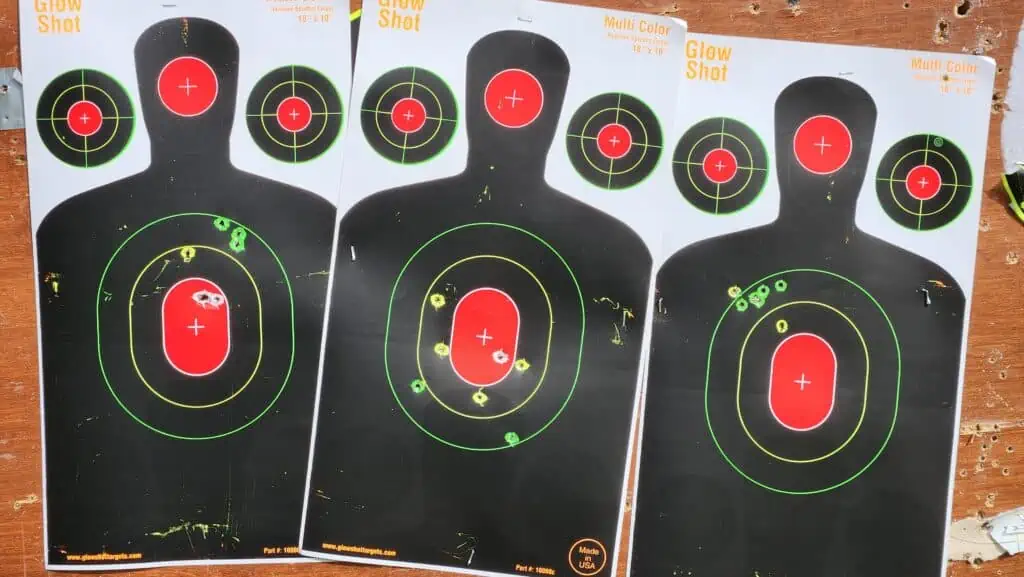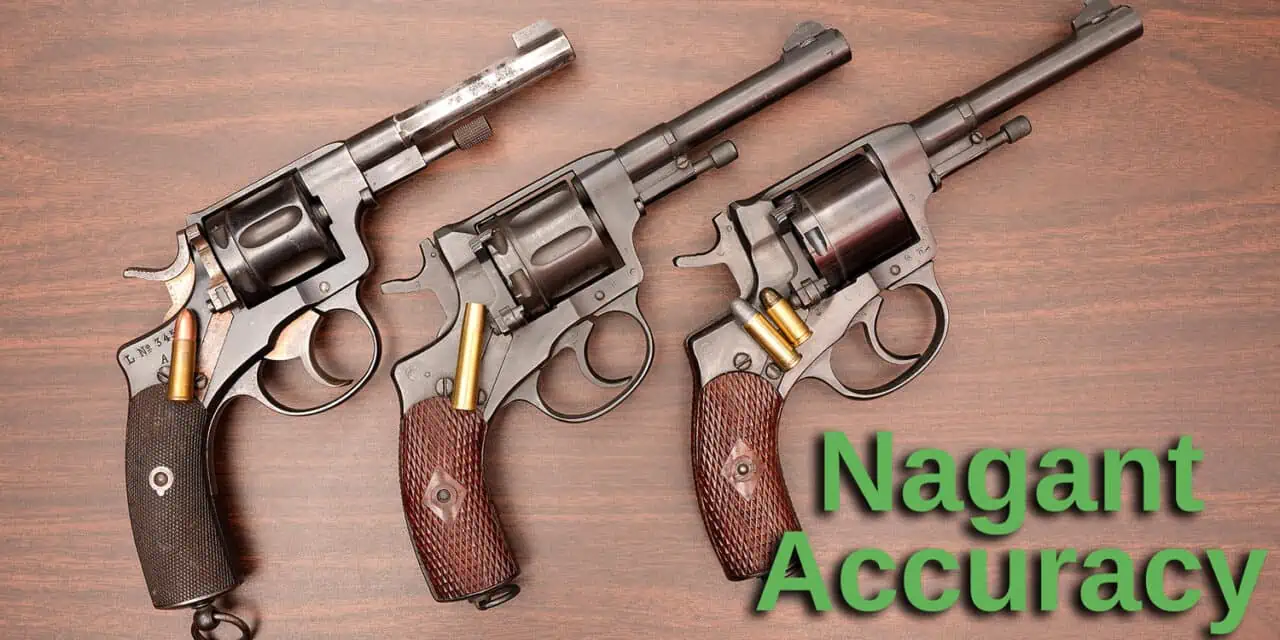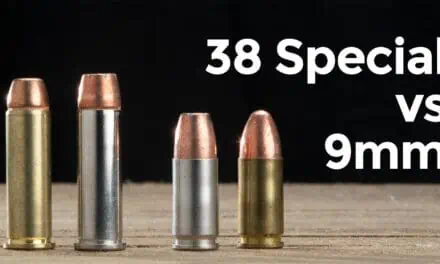At the end of the 19th century, progress and modernity caught up with the world of military handguns.
Smokeless powder and jacketed bullets replaced black powder and soft lead in most militaries. The 1899 Hague convention outlawed expanding bullets for warfare, but even before that most major combatants were emphasizing penetration in the specifications. A typical military cartridge went from 11mm down to about 8mm. With it, shooters enjoyed a slight increase in muzzle velocity. British Webleys and American Smith & Wesson top breaks aside, most European armies ended up with slim double action side-gate loading revolvers in the 7.5mm to 8mm range. While the swing-out cylinder patent dates to 1865, it was 1892 before the government issued such a sidearm to American troops. But while the US went right back to .45 Colt chambering, Europe switched to smaller calibers launching roughly 100 grain bullets. Muzzle velocity stayed low, around 700 to 750 feet per second. Europeans considered that plenty for officers’ sidearms.
Here Comes the Nagant

Oleg, the author at the firing range after seven shots at ten yards with another sample of Nagant.
Enter the odd and innovative 1895 “gas seal” Nagant. It became the standard Russian and Soviet sidearm until the mid-1930s, and mechanized troops still used it widely in 1945. While gas seal in itself is an old expedient — used by flintlock Collier and percussion Savage revolvers in the early and mid 1800s respectively — doing it with a metallic cartridge worked far better. The articulated cylinder moved forward around the cone-shaped forcing cone, and the unusually long cartridge case with brass protruding past the bullet front completed the effective seal. Loaded just a little hotter than the Swiss, the Austrian, and the French counterparts, 7.62x38R reached about 980 feet per second. Even then, you can’t call it a “powerhouse.”
Popular Despite Complexities
In a gun with 4.5 inch barrel and mild 11,000 psi cartridge, cylinder gap pressure loss of 30-40 feet per second was not significant enough to warrant the extra complexity. However, this design remained popular for decades. It performed fairly well despite some wartime production samples showing very poor machining and fit. Even relatively crude fixed-cylinder designs are easier to machine than swing-out cylinders. So, it’s very likely that the Russia and USSR opted to stay within their level of manufacturing competency. The best-made samples of this type remained in target competitions until the early 21st century, with one shooter using a Nagant-derived TOZ49 to set a world accuracy record in 2007. Subsonic velocity of this round came in handy for sound suppression. Nagant is also unique in the capability for effective revolving carbine conversions. In other types, the cylinder gap becomes increasingly problematic as the barrel gets longer.
The camming required for the back-and-forth cylinder movement made the double action pull extremely heavy, around 20lbs. Many 1895 Nagants were produced with single action only triggers. Manufactured with pyramid front and simple notch rear sights, 1895s proved unusually accurate. I had a theory that the forward motion of the cylinder helped to center the firing chamber against the forcing cone, and the gas-sealing case not only helped the centering but also reduced the free bore. The little flat point bullet with lots of bearing surface became an accidental target wadcutter, making the best of the indifferently manufactured gun and ammunition. To test this, I employed an 1887 Swedish Nagant in 7.5mm, without gas seal, and two 1930s Soviet-manufactured 1895 revolvers. One of them had the original cylinder, the other an aftermarket cylinder designed for use with 32 ACP and 32 S&W Long ammunition.
Testing the Nagant Revolver Accuracy

Left to right are 32 Long, 32ACP, and 7.62x38R targets used in the comparison.
Test firing off-hand, single action from 10 yards, I got a consistent ranking of accuracy.
32 ACP shot least well. 7.5mm Swiss/Swedish (both countries used the same cartridge) in a tie with 32S&W Long, and — the best of the lot — the actual x38R Nagant ammunition rounded out our testing.

Our target from the 7.5mm Swiss/Swedish testing.
One of the shots from the Swedish gun destabilized and keyholed. The rest gave a consistent group that wasn’t as good as I would have expected given the much nicer fit and finish of the revolver compared to the Soviet samples.
None of the groups went close to the sight picture. In the case of x38R that could have been caused by my use of downloaded 700 feet per second target loads rather than original military ammunition. Previously, I fired other ammunition loaded by the same factory. From that experience, I can state that their quality control wasn’t great. Any accuracy achieved was due more to the revolver design than to the cartridge consistency.
The results of 32S&W Long relative to 32 ACP were not too surprising: shorter freebore and better obturation thanks to its softer lead bullet likely produced the improved accuracy.
Other Perks
The absence of the cylinder gap flash and the attendant noise came as a welcome bonus to the improved accuracy. On a clean 1895, empties will fall out under gravity, while a dirty gun requires slow and laborious use of the ejection rod. Inspired by more modern designs, Nagant started producing a swing-out model in 1910, but few were sold. Turns out that simultaneous ejection of seven very long cases with just thumb pressure is less reliable than sequential ejection of single cases. That problem wasn’t solved by 1914, when German conquest of Belgium put an end to the experiments. Today, despite around 2 million 1895 Nagants in the world, it seems only Fiocchi and PPU load the ammunition. For American shooters, a conversion cylinder with 32S&W Long appears to be the best way to keep these relics running with acceptable accuracy.
Slightly longer and more energetic 32 H&R Magnum ammunition may be used in conversion cylinders only. It provides power level similar to the original cartridge, along with accuracy similar to 32S&W Long.






